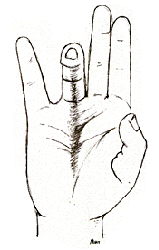Dupuytren’s disease
 Dupuytren’s disease is an abnormal thickening of the fascia (the tissue just beneath the skin of the palm). It often starts with firm lumps in the palm. In some patients, firm cords will develop beneath the skin, stretching from the palm into the fingers Gradually, these cords may cause the fingers to bend into the palm. Most of the time the tendons are not directly involved.
Dupuytren’s disease is an abnormal thickening of the fascia (the tissue just beneath the skin of the palm). It often starts with firm lumps in the palm. In some patients, firm cords will develop beneath the skin, stretching from the palm into the fingers Gradually, these cords may cause the fingers to bend into the palm. Most of the time the tendons are not directly involved.Causes: The cause of Dupuytren’s disease is unknown. The pathology is more common in men over age 40. The cause of Dupuytren's contracture is not known. It is not caused by an injury or trauma.
Symptoms and signs: Symptoms of Dupuytren’s disease usually include a small lump or series of lumps in the palm. Gradually a cord may develop, extending from the palm into one or more fingers, usually the ring and little fingers are involved. The initial nodules may produce discomfort that usually resolves, but Dupuytren’s disease is not typically painful. The disease may first be noticed because of difficulty placing the hand flat on a table. Progression is unpredictable. Some individuals will have only small lumps or cords while others will develop severely bent fingers. More severe disease often occurs with an earlier age of onset.
Treatment: There is no way to stop or cure the problem. Dupuytren's contracture usually progresses very slowly for years. In some cases, only observation is needed for nodules and cords that are not contracted. Patients with more advanced contractures may require surgery in order to improve function. Various surgical techniques are available in order to correct finger position. The goal of surgery is to improve finger position. Despite surgery, the disease process may recur.
- Il pollice dello sciatore
- Rizoartrosi
- Cisti del polso
- DeQuervain’s tendinitis
- Dupuytren’s disease
- Cubital Tunnel Syndrome
- Lo scafoide carpale
- Cisti della IFP
- Trigger finger
- Carpal Tunnel Syndrome
- Cisti della puleggia
- Epicondilite o gomito del tennista
Luchetti MD

SICM PresidentItalian Society for Surgery of the Hand
ISSPORTH PresidentInternational Society for Sport Traumatology of the Hand






